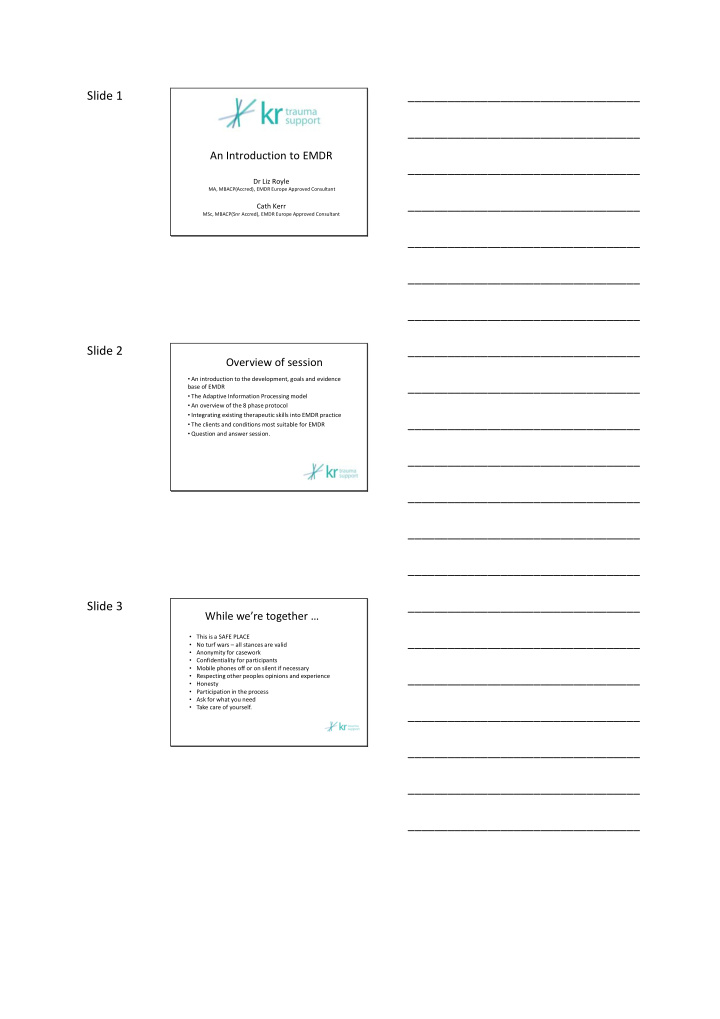



Slide 1 ___________________________________ ___________________________________ An Introduction to EMDR ___________________________________ Dr Liz Royle MA, MBACP(Accred), EMDR Europe Approved Consultant ___________________________________ Cath Kerr MSc, MBACP(Snr Accred), EMDR Europe Approved Consultant ___________________________________ ___________________________________ ___________________________________ Slide 2 ___________________________________ Overview of session • An introduction to the development, goals and evidence ___________________________________ base of EMDR • The Adaptive Information Processing model • An overview of the 8 phase protocol • Integrating existing therapeutic skills into EMDR practice ___________________________________ • The clients and conditions most suitable for EMDR • Question and answer session. ___________________________________ ___________________________________ ___________________________________ ___________________________________ Slide 3 ___________________________________ While we’re together … • This is a SAFE PLACE ___________________________________ • No turf wars – all stances are valid • Anonymity for casework • Confidentiality for participants • Mobile phones off or on silent if necessary • Respecting other peoples opinions and experience ___________________________________ • Honesty • Participation in the process • Ask for what you need • Take care of yourself. ___________________________________ ___________________________________ ___________________________________ ___________________________________
Slide 4 ___________________________________ EMDR will save the world! ___________________________________ ___________________________________ ___________________________________ ___________________________________ ___________________________________ ___________________________________ Slide 5 ___________________________________ What are your impressions, questions or thoughts about ___________________________________ EMDR? ___________________________________ Is there anything in particular you would like to get from today? ___________________________________ ___________________________________ ___________________________________ ___________________________________ Slide 6 ___________________________________ So just what is EMDR? EMDR is an evidence-based psychotherapy for Post- ___________________________________ Traumatic Stress Disorder (PTSD) EMDR addresses the experiences that contribute to clinical conditions and those needed to bring the client to a robust state of psychological health (Shapiro, 2007) ___________________________________ Successful outcomes and positive research are also well- documented in the literature for EMDR treatment of other trauma-related mental health disorders and ___________________________________ somatic symptoms. ___________________________________ ___________________________________ ___________________________________
Slide 7 ___________________________________ The “discovery” of EMDR A chance discovery by clinical psychologist Dr Francine ___________________________________ Shapiro in May 1987 Eye Movement Desensitisation Controlled study 1988-89 with 22 victims of rape, abuse and Vietnam combat trauma ___________________________________ 1990 Continued refinement of protocols leading to Eye Movement Desensitisation and Reprocessing. ___________________________________ ___________________________________ ___________________________________ ___________________________________ Slide 8 ___________________________________ Aim of EMDR for clients EMDR targets past experiences, current triggers, and future ___________________________________ potential challenges, in working towards: • Alleviating presenting symptoms • Decreasing or eliminating distress from the disturbing memory ___________________________________ • Relief from bodily disturbance • Resolution of present and future anticipated triggers ___________________________________ • Improving view of the self. ___________________________________ ___________________________________ ___________________________________ Slide 9 ___________________________________ The evidence base for EMDR A 2007 survey of 38 randomised clinical trials ___________________________________ established that EMDR and Trauma Focused Cognitive Behaviour Therapy (TFCBT) are the two most effective treatments for PTSD ___________________________________ In the UK, EMDR is one of the two recommended treatments for PTSD in the guidelines of the National Institute of Clinical Excellence (NICE). Clinical trials and research http://www.emdria.org/displaycommon.cfm?an=1&s ___________________________________ ubarticlenbr=2 ___________________________________ ___________________________________ ___________________________________
Slide 10 ___________________________________ Memory networks • Memories are stored as sensory input with associated thoughts, beliefs and feelings as well as body sensations ___________________________________ • Memories with similar information are linked by their channels of association and stored in memory networks • Adaptive memory networks are the primary basis of our learning, self-esteem, positive growth and adaptive resources ___________________________________ and behaviours • Maladaptive networks are the primary basis of pathology • Memories are considered “dysfunctional” because they are physiologically stored in a way that does not allow them to link ___________________________________ to any positive/adaptive networks. ___________________________________ ___________________________________ ___________________________________ Problems with dysfunctionally Slide 11 ___________________________________ stored memories Disturbing memories are dysfunctionally stored as they were ___________________________________ perceived at the time of the event, with the associated emotions, physical sensations, thoughts and beliefs These can be readily triggered possibly because the individual is not able to differentiate between past and present The perceptions of current situations link into the networks ___________________________________ of physically stored memories in order to be interpreted If a memory network contains an unprocessed memory, the current perceptions are formed by the earlier unsettling emotions, thoughts, beliefs, and physical sensations of the ___________________________________ past event . ___________________________________ ___________________________________ ___________________________________ Slide 12 ___________________________________ Adaptive v maladaptive Christian, ___________________________________ Remembers being praised by a teacher, feeling glow of pride, physically relaxed, “I’m capable” Julie, ___________________________________ Remembers being criticised in front of class, feels fear and shame, tense, “I’m incapable” ___________________________________ Current interpretations? ___________________________________ ___________________________________ ___________________________________
Slide 13 ___________________________________ Memory channels of association Think of a current issue that is a minor disturbance ___________________________________ e.g. public speaking, someone who irritates you, minor stress around a piece of work to be done ___________________________________ Bring up the image Notice the negative belief that you hold about this situation Notice the emotion and where you feel it in your ___________________________________ body ___________________________________ ___________________________________ ___________________________________ Slide 14 ___________________________________ The Adaptive Information Processing (AIP) model ___________________________________ When we experience a distressing event, over time, the information processing system unhooks the disturbing emotions, thoughts, physical sensations connected to an event, resulting in adaptive resolution, thus constructing functional memories and memory networks ___________________________________ This physical information processing system, has a natural tendency to be guided towards wellbeing. ___________________________________ ___________________________________ ___________________________________ ___________________________________ Slide 15 ___________________________________ The AIP model During the phase of reprocessing the maladaptive / dysfunctional memory networks start to link with existing ___________________________________ positive, adaptive and functional memory networks As a result of EMDR – activated Adaptive Information Processing, emotional and physical disturbance is ___________________________________ desensitized. Furthermore, there is an emergence of insight and positive changes in physical and emotional responses Consequently this culminates in integration, when the new learning becomes available in the current life situation. ___________________________________ ___________________________________ ___________________________________ ___________________________________
Recommend
More recommend